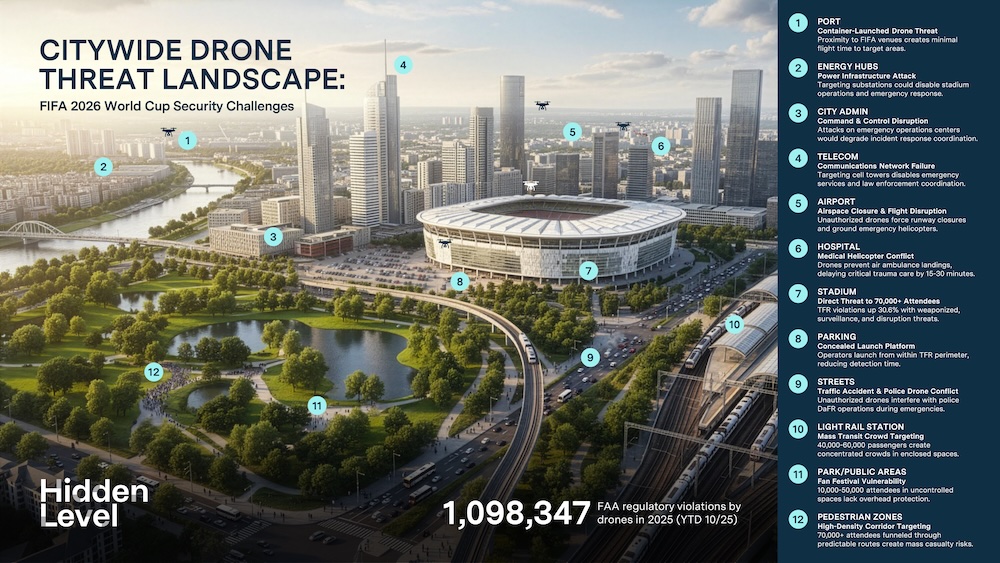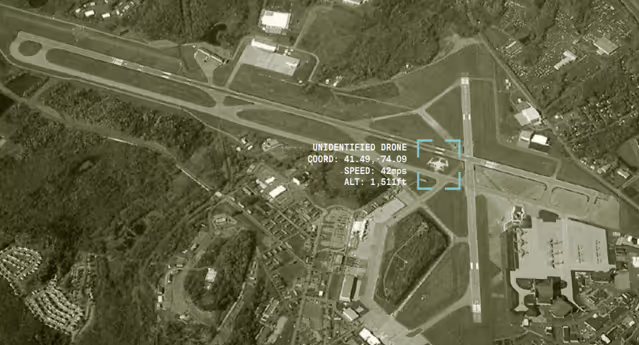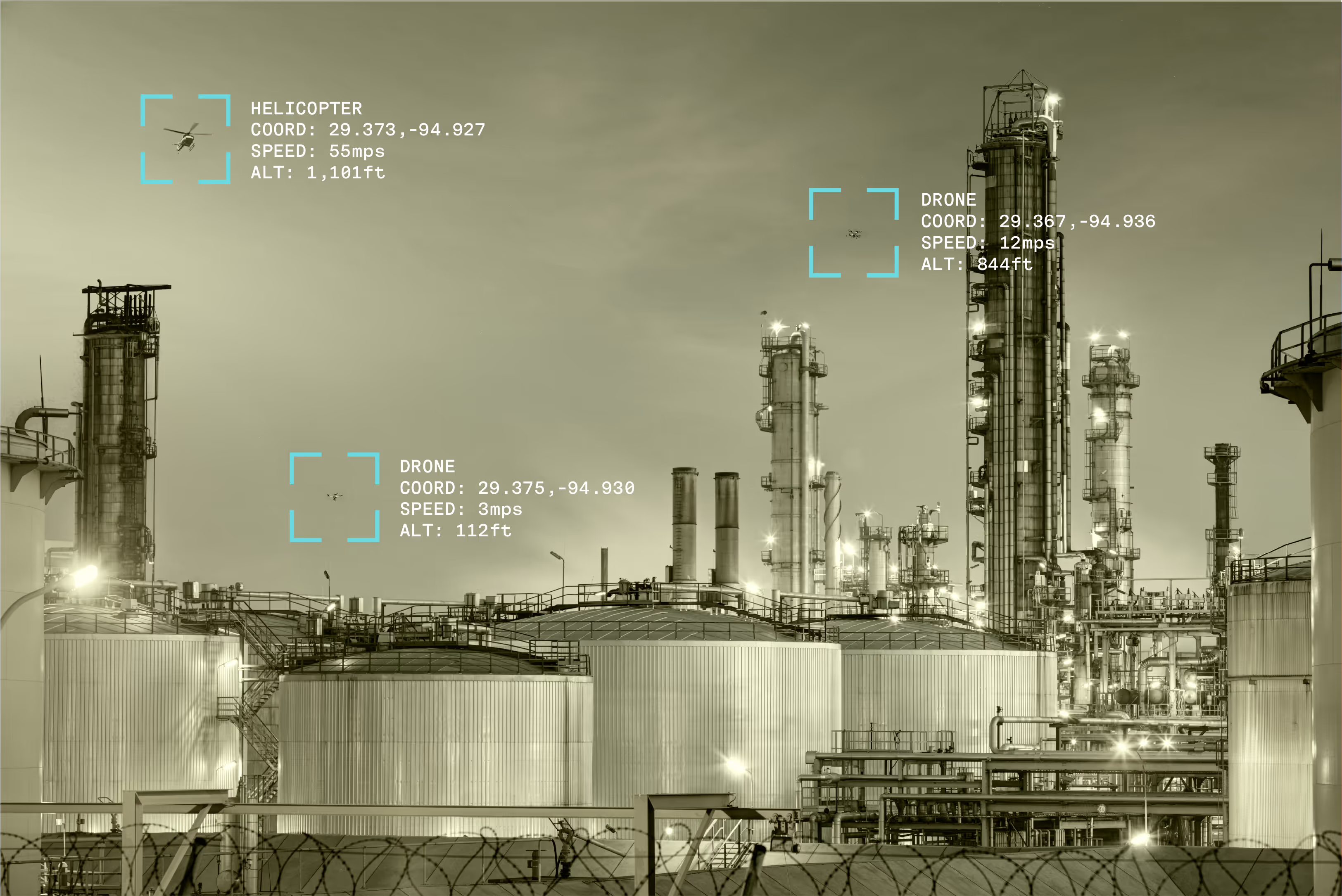America’s Homeland Defense Has a Blind Spot — and It’s Right Over Our Heads

When the 2026 FIFA World Cup begins, America will face a quiet test of readiness: can we protect the skies above our own cities?
For years, security professionals have warned that drones have opened a new, largely unmonitored front in our defenses, stretching across stadiums, power substations, and emergency corridors nationwide.
Drones aren’t gadgets anymore. They’re tools for intelligence gathering, disruption, and in some cases, weaponization. Yet the low-altitude airspace where they fly, below 400 feet, remains our biggest blind spot. We’ve secured our borders, coasts, and networks. But over our cities, the sky is still wide open.
A Quiet Escalation
The trend line is unmistakable. Unauthorized drone activity around airports, stadiums, and power facilities has jumped dramatically. Near misses have forced aircraft to divert. Temporary Flight Restriction (TFR) zones over stadiums are violated weekly. What once seemed like isolated incidents are now part of a daily reality for local law enforcement.
When the 2026 World Cup kicks off — eleven host cities, more than a hundred matches, and millions of visitors— these challenges will multiply. Each game will pack 70,000 to 80,000 people into open-air arenas. But the challenge extends far beyond the stadium walls. It’s about the connective tissue of the modern city, the roads, ports, cell networks, and power grids that make large-scale events possible. It doesn’t take an army of drones to cause chaos. A few in the wrong place can ripple across a city’s power, communications, and response systems.
America’s Missing Layer of Defense
The U.S. has invested heavily to strengthen its borders, ports, and digital infrastructure, yet most cities still can’t see what’s flying a few hundred feet above their own streets. That’s not neglect. It’s legacy. Traditional radar and air traffic control systems were built for a different era — one of high-altitude jets and predictable flight paths. They simply can’t detect small, fast, or silent drones that weave through buildings and highways at ground level.
Even when those drones are detected, local police are often powerless to act. Federal law gives the FAA exclusive authority over U.S. airspace, and only a handful of federal agencies have the legal authority to disrupt or disable drones. That leaves local agencies stuck watching a threat they can’t touch and a gap adversaries can exploit in seconds.
Major General Gent Welsh, Washington State’s Homeland Security Advisor, put it plainly:
I’m concerned that we face another 9/11-style attack with the proliferation of attack drones these days. They’re everywhere. I’m just worried it’s a matter of when, not if.
In Ukraine, drones have changed the nature of conflict overnight. Swarms launched from hidden positions. Autonomous drones navigated without GPS or radio signals. These are futristic scenarios. They're playbooks being written in real time and easily adapted with technology that anyone can buy online.
Twelve Vectors of Vulnerability
When you view a city through the lens of drone risk, the scale of exposure becomes clear. The stadium may be the focal point of the World Cup, but it’s only one node in a vast network of targets. Each system that keeps a city running: energy, transportation, communication, emergency response creates its own opening.

1. Ports: Hidden Launch Pads in Plain Sight
Many ports sit within minutes of host-city stadiums. Thousands of containers arrive and depart daily, too many to inspect in real time. A single preloaded shipping container could conceal multiple drones programmed to launch autonomously toward nearby venues or infrastructure.
2. Power Infrastructure: The Force Multiplier
Electric substations and generation facilities are magnets for disruption. A small drone could disable transformers, black out sections of a city, and cripple the stadium’s emergency power. Unauthorized flights over power plants are climbing every year and each one represents a potential chain reaction.
3. Command and Control Centers: Striking the Nerve
Emergency operations centers and 911 hubs form the brain of any coordinated response. Surveillance drones nearby can capture security positions, radio traffic, or personnel movements, and intelligence that adversaries can use in real time.
4. Communications Networks: One Drone, Citywide Chaos
During major events, cell networks strain under the load. A few drones targeting key towers or fiber junctions could silence entire neighborhoods. Without mobile service, ticketing systems crash, emergency calls fail, and situational awareness evaporates.
5. Airports: Where Safety and Chaos Converge
Most host cities operate within dense, overlapping airspace zones. Unauthorized drones near runways already cause delays that ripple across the country. During the World Cup, a single airspace violation could ground law enforcement air support or halt medical flights when they’re needed most.
6. Medical Helicopters: Seconds That Decide Lives
A drone in hospital airspace halts all landings immediately. During a mass-casualty incident, those lost minutes translate directly to lives. Air ambulances can’t “fly around” a drone, they must abort.
7. Stadiums: The Obvious and Persistent Target
Despite strict FAA restrictions, violations continue to climb. Many are careless fans chasing a viral shot; others are deliberate incursions testing law enforcement response times. Yet local officers still lack the authority to disable the aircraft themselves.
8. Parking Infrastructure: Concealed Launch Zones
Parking lots around major venues offer perfect cover for drone operators — crowded, chaotic, and within line of sight to the target. A drone can be launched from a parked car in seconds and be airborne before anyone notices.
9. Traffic Corridors: Collisions and Drone Conflicts
Highways leading to stadiums become choke points on game days. When accidents occur, police drones responding to the scene may suddenly share airspace with hobbyists or bad actors, forcing authorized aircraft to land.
10. Mass Transit Hubs: High Density, Low Escape
Transit stations move tens of thousands of people through confined spaces. Unauthorized drones in these area scan surveil crowd flow or, worse, disrupt evacuations during emergencies.
11. Fan Festivals: Congestion in the Skies
Beyond the stadiums, fan zones will host thousands more. Most unauthorized flights here won’t be malicious, but dozens of hobby drones crowding the same airspace still create dangerous conditions and complicate enforcement.
12. Pedestrian Corridors: Predictable Targets
Crowd movements before and after games follow a clear pattern, large groups, narrow pathways, and no overhead cover. Those predictable choke points make drone-based attacks especially hard to defend against.
Download the Infographic
Interconnected Vulnerabilites
Each vector alone is concerning. Together, they form a system that’s dangerously interdependent. Power failures stall communications. Communication failures cripple emergency response. A cascading chain can unfold in minutes, triggered by a handful of drones.
The Cascading Failure Scenario
Understanding each vulnerability in isolation is only half the story. The real danger comes when multiple systems fail together with one triggering the next in a chain reaction that overwhelms even the best-prepared city.
· T–2 hours: Surveillance drones quietly map security positions. Preloaded drones sit hidden at a nearby industrial site.
· T–30 minutes: A small swarm strikes an electrical substation, triggering partial blackouts.
· Kickoff: Multiple drones launch, targeting the stadium, fan zones, and a key cell tower. Cell service collapses.
· T+10 minutes: Confusion spreads. Police deploy drones to monitor traffic incidents, but unauthorized drones force them to land.
· T+30 minutes: Emergency operations center struggles to coordinate without communication. Federal response is mobilized, but jurisdictional boundaries slow action.
This isn’t a screenplay. Every element is based on documented incidents and real-world tactics. The question isn’t if this scenario could happen, it’s whether we’ll close the gap before it does.
Persistent Airspace Awareness as the Fourth Layer
Persistent airspace awareness means creating a shared, real-time picture of everything flying below 400 feet and giving that visibility to every agency that needs it.
What It Provides
· Real-Time Detection: Passive sensors track drones by their signal patterns, identifying the aircraft, path, and operator without radar emissions.
· Shared Visibility: Data from distributed sensors gives local, state, and federal partners one common view.
· Jurisdictional Bridge: Awareness enables local agencies to coordinate with authorized partners who can act.
· Always On: Persistent networks protect daily operations — not just special events.
· Forensic Value: Detection data provides evidence for prosecution and future prevention.
DHS Funding and Interagency Coordination
Through DHS grant programs, cities and states can strengthen airspace security ahead of the World Cup and build systems that deliver daily safety long after.
Most airspace incidents start at the local level — a drone spotted over a stadium, near a hospital, or around critical infrastructure. But drones don’t follow jurisdictional lines. They can cross city limits or county borders in seconds, forcing city police, county emergency managers, state operation centers, and federal partners to react at once. Without shared visibility, each agency ends up responding to a different version of the same event.
Persistent airspace awareness creates a common operating picture that bridges those gaps. Alerts flow simultaneously to local responders, county emergency management, state operations centers, and federal liaisons, everyone seeing the same track, the same operator, at the same time.
The Authority Gap: Federal Law, Local Action, and System Integration
Under current law, only a few federal agencies can physically disable or destroy drones. But local and state police can interdict the operator, and that’s often the quickest, safest way to end the threat.
Real-time detection that pinpoints operator location is essential. It allows local officers to arrest the person behind the controls while authorized partners handle the aircraft itself.
At the same time, work is in progress to authorize mitigation tools — jamming, RF takeover, and other non-kinetic methods — for federally approved entities to bring down rogue drones safely. That makes accurate, rapid integration between detection systems and effectors critical. If a city PD can’t feed a verified drone track directly to the federal team running the jammer, precious seconds are lost.
The goal isn’t to give local agencies new legal powers, it’s to ensure that when a threat appears, everyone acts from the same trusted data.
Detection fuels interdiction. Integration fuels speed. Together, they close the response gap.
2026 Is Tomorrow
The first World Cup match in the U.S. kicks off in June 2026, just months away.
Every participating city will be under a global microscope, managing the most complex low-altitude airspace environment in American history. Unauthorized drone flights near airports and stadiums continue to climb, and each incident offers a preview of what’s coming when international crowds and media drones converge.
The time for experimentation has passed. The technology works. The funding exists. The partnerships are forming. What’s left is to scale what’s proven.
Cities that act now can turn temporary event funding into permanent capability:
· Citywide detection networks that protect critical infrastructure long after the last whistle
· Shared feeds that connect local, state, tribal, and federal responders.
· Standard procedures for airspace awareness that extend beyond the games.
Major General Welsh’s warning bears repeating; it’s not a matter of if, but when. Persistent airspace awareness is how we make sure “when” never happens here.
Building the Fourth Layer
America has secured its borders, guarded its coasts, and hardened its networks. But the airspace just above our cities, where drones operate freely, remains unguarded. It’s the missing fourth layer of homeland defense.
The 2026 World Cup will test that layer in real time. Eleven cities. Millions of people. Weeks of continuous operations under global scrutiny. It won’t just be a sporting event; it will be a national stress test for public safety.
Persistent airspace awareness is how we pass that test. It delivers shared visibility, unified data, and faster coordination across every level of government, turning the blind spot above our cities into the next frontier of homeland security.
See what’s above your city.
Discover how Hidden Level’s Airspace Monitoring Service delivers persistent visibility, faster coordination, and safer skies for events like FIFA 2026 and beyond.
Explore Hidden Level’s FIFA 2026 Airspace Security Initiative











